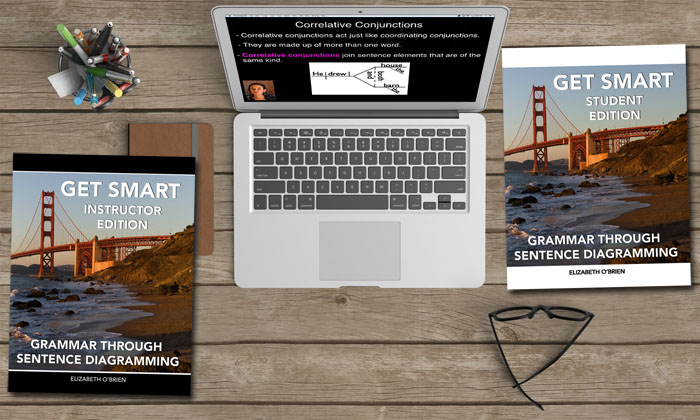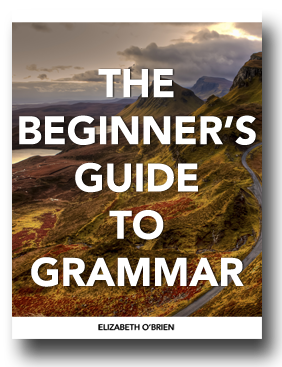📘 Download your free grammar guide here. 📘
📘 Download your free grammar guide here. 📘
What are the parts of speech?
What are the parts of speech?
- Home
- Parts of Speech
Today's the day for you to learn about this important grammatical concept! But first...let's see what the parts of speech have to do with your clothes.
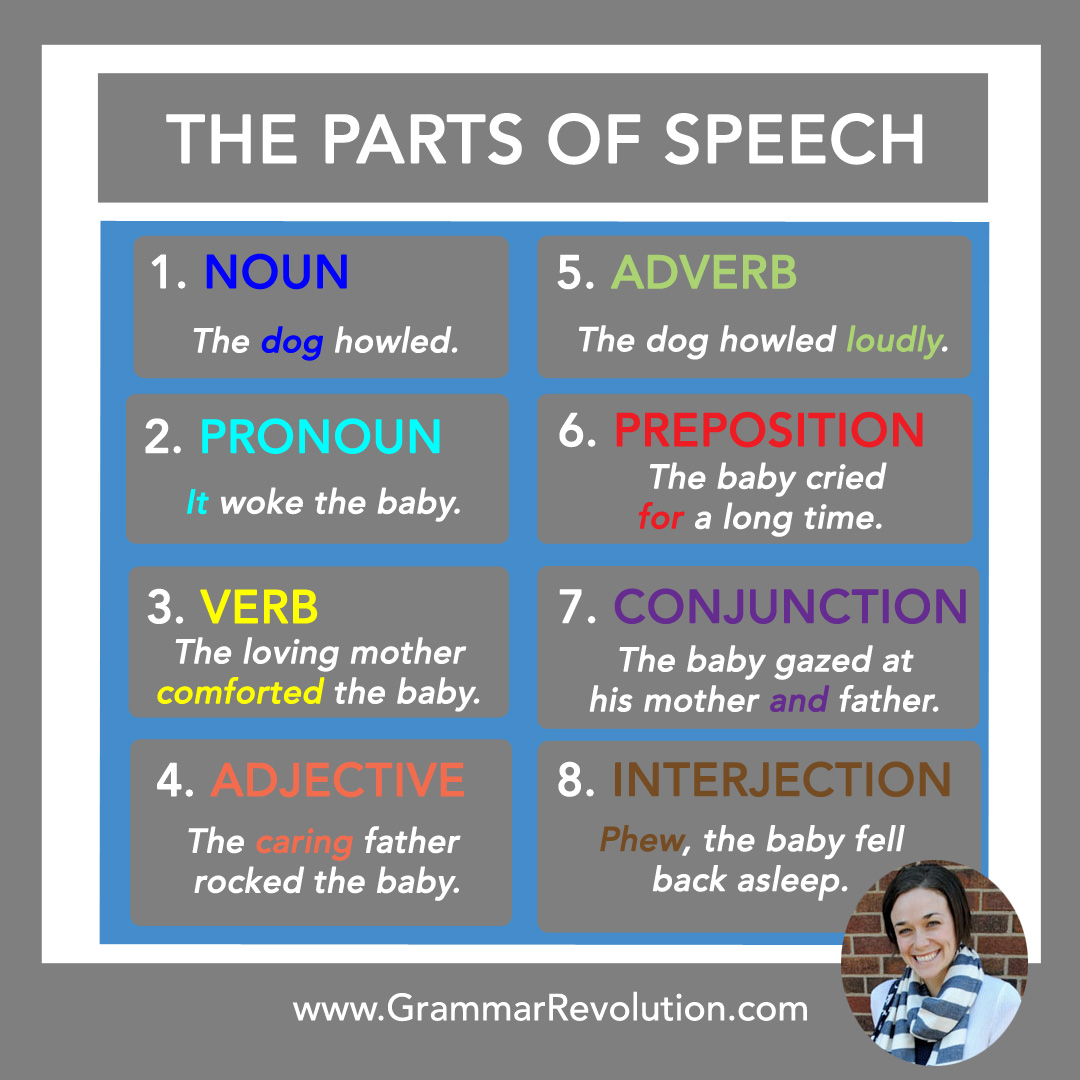
Imagine that it's laundry day, and you've just finished washing and drying your clothes. You dump the contents of the laundry basket onto your bed, and you begin to organize everything. You fold matching socks together, you create a pile of perfectly folded shirts that you would be proud to show Marie Kondo, and you do the same thing with your pants, jackets, and everything else.
In the same way that we organize our clothes into groups based on each item's function and features, we organize our words into categories based on each word's function and features. We call these categories of words the parts of speech.
Some people categorize words into eight parts of speech, and some people categorize them into nine parts of speech. Neither one is wrong; they're just two ways of looking at things. We'll go over these categories below. Here at English Grammar Revolution, we categorize words into eight groups, but I'll tell you about the ninth one as well.
There's one important thing for you to know before we look at these categories: most words can function as more than one part of speech. They will only do one job at a time, but they can do different things in different sentences. Look at the word love in the following sentences.
My love of grammar inspired me to make this website.
Here, love is functioning as a noun. It's the subject of the sentence.
I love you.
Now, love is acting as a verb! It's telling us an action.
The only way we can know how to categorize a word is to look at how it's acting within a sentence.
Okay, let's check out the parts of speech!
The 8 Parts of Speech
1. Nouns
Nouns name people, places, things, or ideas. They're important parts of our sentences because they perform important jobs (subjects, direct objects, predicate nouns, etc.).
A peacock walked through our yard.
The dog howled during the night, and it woke up our whole family.
Sometimes people get bogged down with this part of speech because there are also many subcategories of nouns. This is similar to the way that we have subcategories for our clothes. You may have a whole drawer full of pants, but you may also have different types of pants that you use for different purposes (workout pants, lounge pants, work pants, etc.). This is similar to the way that we can further categorize nouns into smaller groups.
Here are a few of the subcategories of nouns: proper nouns, common nouns, collective nouns, possessive nouns, and compound nouns.
Tip: Other parts of speech also have subcategories. If you're studying this information for the first time, ignore the subcategories and focus on learning about each broader category.
2. Pronouns
Pronouns take the place of nouns. When most people hear the word pronoun, they think of words like I, we, me, he, she, and they. These are indeed all pronouns, but they're a part of a subcategory called personal pronouns. Know that there are other kinds of pronouns out there as well. Here are some examples: myself, his, someone, and who.
Here are a few of the subcategories of pronouns: reflexive pronouns, indefinite pronouns, possessive pronouns, and relative pronouns.
When we walked across the bridge, we saw someone who knows you.
I will fix the dishwasher myself.
3. Verbs
Verbs show actions or states of being. They are integral elements of sentences.
The shuttle will fly into space.
The loving mother comforted and soothed the baby.
In the Montessori tradition of education, they use a large red circle or ball to symbolize a verb, and they often teach children to think of verbs as a sun providing the energy of a sentence. Isn't that a lovely way to think of verbs?
I know that you're getting tired of hearing about subcategories, but linking verbs, action verbs, and helping verbs are described on the verb page here.
Modal verbs are described on that link, and you can learn even more about action verbs and linking verbs from those links.
4. Adjectives
Adjectives describe, or modify, nouns and pronouns. I like to think of them as adding color to language. It would be hard to describe a beautiful sunset or the way a touching story makes us feel without using adjectives.
The wise, handsome owl had orange eyes.
The caring father rocked the baby.
One helpful strategy for learning about and identifying adjectives is to learn how they are diagrammed. Sentence diagrams are pictures of sentences that help us see how all of the words are grammatically related. Since adjectives modify nouns and pronouns, we diagram them on slanted lines under the nouns/pronouns that they are modifying.
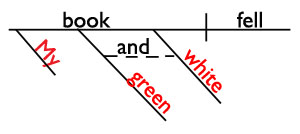
My green and white book fell.
Book is a noun. It's the subject of this sentence. My, green, and white are all adjectives describing book, so we diagram them on slanted lines underneath book. Isn't that a great way to SEE what adjectives do?
Nine Parts of Speech
When people categorize words into eight parts of speech, they say that articles/determiners (a, an, the, this, that, etc.) are subcategories of adjectives.
When people categorize words into nine parts of speech, they say that articles/determiners make up their own category and are not a part of the adjective category.
5. Adverbs
Adverbs modify (describe) verbs, adjectives, and other adverbs. Adverbs are similar to adjectives in that they both modify things.
The extremely cute koala hugged its mom very tightly.
The dog howled loudly.
Sentence diagrams also make it really easy to see what adverbs do. Take a look at this diagram. What do you notice about the way the adverbs are diagrammed?
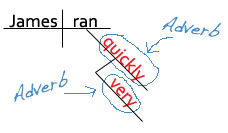
James ran very quickly.
Did you notice that the adverbs are diagrammed on slanted lines under the words that they are modifying?
Ran is a verb. Quickly is an adverb telling us more about the verb ran. Very is an adverb telling us more about the adverb quickly.
Doesn't the diagram make it easier to SEE what adverbs do?
6. Prepositions
Prepositions are probably the most difficult part of speech to explain, but people generally have an easier time understanding them when they look at lots of examples. So...let's start with some examples of commonly used prepositions!
in, for, of, off, if, until
The frog sat in the flower.
The baby cried for a long time.
I'm so convinced that memorizing some of the prepositions will be helpful to you that I'll teach you a preposition song.
Okay, now that we've looked at some examples, let's look at the definition of a preposition.
Prepositions show the relationship between a noun or a pronoun and some other word in the rest of the sentence.
Sentence diagrams will come to the rescue again to help us visualize what prepositions do. Think of prepositions as "noun hooks" or "noun bridges." In the diagram below, notice how the preposition down links the noun tree to the rest of the sentence.
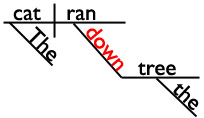
The cat ran down the tree.
Since prepositions always function as "noun hooks," they'll always be accompanied by a noun. The preposition plus its noun is called a prepositional phrase.
If you find a word from the preposition list that's not a part of a prepositional phrase, it's not functioning as a preposition. (You remember that words can function as different parts of speech, right?)
7. Conjunctions
Conjunctions join things together. They can join words or groups of words (phrases and clauses).
The hummingbird sat and waited.
The conjunction and is joining the words sat and waited.
Do you live near the park or near the hospital?
The conjunction or is joining the phrases near the park and near the hospital.
The two conjunctions we just looked at (and and or) belong to a subcategory called coordinating conjunctions, but there are other subcategories of conjunctions as well. The other one that we use most often is subordinating conjunctions. Subordinating conjunctions are a little trickier to learn because they involve a more complicated concept (dependent adverb clauses).
For now, just know that all conjunctions, no matter what type they are, connect things together. In fact, let's LOOK at how they do this by looking at a sentence diagram.
Here is a sentence diagram showing how the coordinating conjunction and connects two clauses.
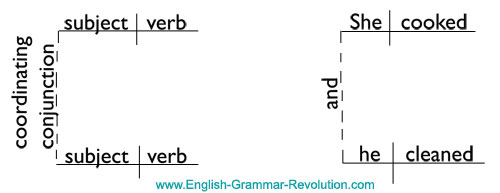
She cooked, and he cleaned.
8. Interjections
Interjections show excitement or emotion.
Wow! That jump was amazing!
Phew, the baby finally fell asleep.
They are different from the other parts of speech in that they're not grammatically related to the rest of the sentence, and the way that we diagram them reflects that. Look at how we diagram interjections:
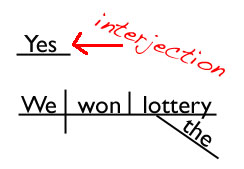
Yes! We won the lottery!
The interjection yes sit sits there on its own line floating above the rest of the sentence. This helps show that it's not grammatically related to the other words in the sentence.
Summary
It's time to review what we covered on this page.
- We can categorize the words that we use into groups based on their functions and features. We call these groups the parts of speech.
- Many words can function as multiple parts of speech. You need to look at each word in the context of a sentence in order to say what part of speech it is.
- The eight parts of speech are nouns, pronouns, adjectives, verbs, adverbs, conjunctions, prepositions, and interjections.
- You just learned about all of the parts of speech. Give yourself a high five!
If you'd like to teach or learn grammar the easy way—with sentence diagrams—check out our Get Smart Grammar Program.
It starts from the very beginning and teaches you grammar and sentence diagramming in easy, bite-size lessons.

Hello! I'm Elizabeth O'Brien, and my goal is to get you jazzed about grammar.
This is original content from https://www.english-grammar-revolution.com/parts-of-speech.html
Our Free Guide Gives You A Fun Way
To Teach And Learn The Basics v
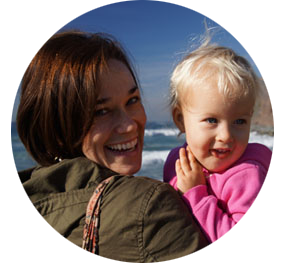
Elizabeth O'Brien is the creator of Grammar Revolution.
Her lessons are guaranteed to give you more confidence in your communication skills and make you smile. :)
Other Helpful Resources
- Learn more about how Montessori classrooms teach the parts of speech.
